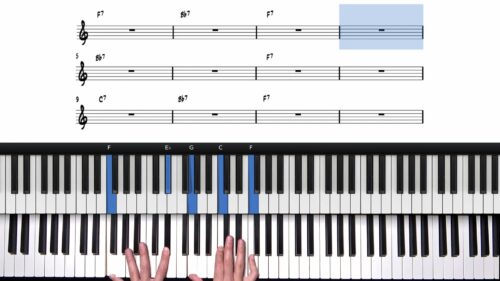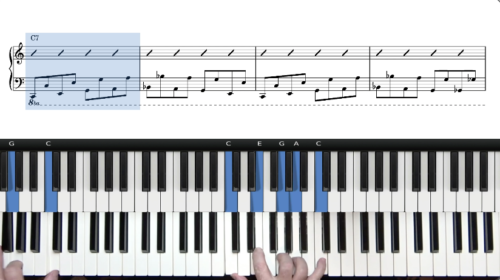Diatonic Walkups in Blues Progressions
Welcome to this lesson on incorporating diatonic walk-ups into the slow 12 bar blues progression in C. In this lesson we will explore the anatomy of walk-up phrases and how they can enhance our blues playing, especially in the 7th and 8th bars of a blues progression.
By the end of this lesson, you will understand the theory behind diatonic chord walk-ups, learn how to apply these walkup phrases to the 12 bar blues in C, and discover how to resolve them convingingly into the final line of the 12 bar blues.
Understanding Diatonic Chords
Diatonic chords are those that belong to a specific key. For example, in the key of C, the diatonic triads and 7th chords are formed from the notes of the C major scale. This means when playing in the key of C, we can use these chords to create harmonic progressions or even write an entire song!
In a blues context, while we often use dominant chords like the C7 as the tonic chord, we can still integrate diatonic chord movements, particularly with walk-ups, to add more harmonic interest to our playing.
The Diatonic Walkup Phrase
In this lesson, we introduce a diatonic walk-up that starts on the tonic (the 1 chord) and moves through diatonic triads and 7th chords. This walk-up can be used effectively in the 7th and 8th bars of a blues progression to build momentum leading into the final bars:

The walkup moves from C major (1 chord) to D minor (2 chord), E minor (3 chord), and the through Eb7 (b3 dominant chord), creating a smooth transition and resolution down to D minor in bar 9. This slight variation of resolving to D minor instead of D7 creates a different feel to the 12 bar blues progression.
Using the C Major Blues Scale
To fill the space between the walk-up chords, we introduce melodic embellishment using the C major blues scale. We target the chord tones of each chord in the walk-up to create melodic embelishment that is in sync with the underlying harmony.

This scale works well over many of the diatonic chords in the progression and adds a bluesy flavour to the walk-up sequence. We discuss how to target specific notes, like the sharp 11 of Eb7 chord to create extra tension and a stronger resolution into the D-7 chord in bar 9.
Exploring Bass Lines and Reharmonisations
This lesson also covers various left hand bass options to accompany our walk-up phrases such as using root notes or alternatively 10th intervals to create a fuller sound.

Additionally, we explore reharmonization techniques like substituting chords and using passing diminished chords, which add harmonic complexity to the blues progression.
Practice Tips
Visualize the Chords: Practice the diatonic triads and 7th chords in the key of C to improve your ability to visualise and incorporate them you blues piano.
Blues Emebellishment: Experiment with the C major blues scale to fill the space between the walk-up chords and embellish the transitions between the chords.
Bass Line Options: Practice root notes and also experiment with 10th intervals in the left hand to develop a fuller and stronger foundation in your walk-up passages.
Reharmonisation: Try using an Ebdim7 chord instead of the Eb7 to add harmoinc interest and variety.







Hello Hayden,
Est-ce qu’il serait possible de pouvoir télécharger les partitions de tout ce que tu joues dans ce module et les autres ? c’est pas facile à suivre sinon.
Merci d’avance.
Bien à toi
Véronique
Hi Véronique,
Yes we will create the PDF notation for this course.
I still have some lessons to record, and as soon as they are finished we will notate all of the demonstrations and make them available as PDF downloads.
Best,
Hayden
Merci beaucoup Hayden.🙏
Toute belle journée.
Bien à toi
Véronique